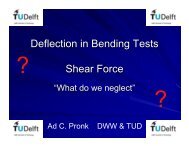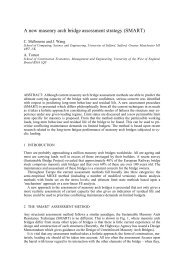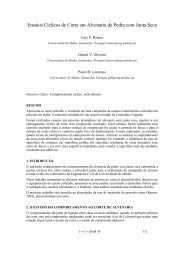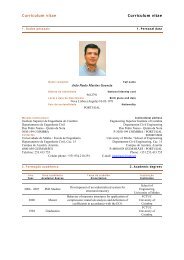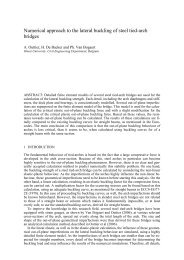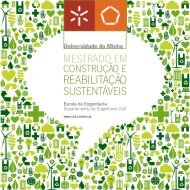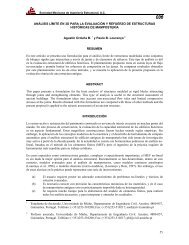Sustainable Construction A Life Cycle Approach in Engineering
Sustainable Construction A Life Cycle Approach in Engineering
Sustainable Construction A Life Cycle Approach in Engineering
You also want an ePaper? Increase the reach of your titles
YUMPU automatically turns print PDFs into web optimized ePapers that Google loves.
Numerical simulations of ash pegs tested under shear loads were carried out to validate previous<br />
results and to calibrate the shear properties of ash.<br />
Different shear length were considered <strong>in</strong> order to evaluate the reliability of the implemented<br />
model to predict both flexural and shear failure modes observed after tests.<br />
The f<strong>in</strong>ite element models of the pegs were implemented with reference to the part under shear<br />
deformations.<br />
On the basis of the calibrated material properties, the f<strong>in</strong>ite element model of the double shear<br />
jo<strong>in</strong>t was implemented.<br />
Due to the symmetry, only a quarter of the jo<strong>in</strong>t was modeled <strong>in</strong> the f<strong>in</strong>ite element analysis.<br />
Three dimensional elements with a plane stress formulation were used to model timber pegs<br />
and plates. In particular, cont<strong>in</strong>uum shell elements SC8R were used. The <strong>in</strong>teraction between<br />
the different parts were modeled us<strong>in</strong>g surface-to-surface contacts. These contacts were applied<br />
at the <strong>in</strong>terface of the p<strong>in</strong> with the hole. Contact was modeled us<strong>in</strong>g the p<strong>in</strong> as master surface<br />
and the hole as slavery surface. Frictionless behaviour of contacts was assumed and small slid<strong>in</strong>g<br />
formulation was selected.<br />
As far as ash, the calibrated mechanical properties were assumed. The properties of fir material<br />
were def<strong>in</strong>ed on the basis of values reported <strong>in</strong> the literature. In particular, the fir characteristics<br />
<strong>in</strong> terms of longitud<strong>in</strong>al tensile and compressive strength were taken from the experimental results<br />
given by Ceraldi et al. 2008. Other parameters were set accord<strong>in</strong>g to the literature.<br />
As far as boundary conditions, full restra<strong>in</strong>ts were considered at one end of the connection. The<br />
model was loaded under displacement control at the other end of the jo<strong>in</strong>t.<br />
The response of the f<strong>in</strong>ite element model was compared with the experimental results given by<br />
Ceraldi et al. 2008.<br />
In general, a good agreement of experimental and numerical results was found for the selected<br />
timber jo<strong>in</strong>t.<br />
In particular, the predicted strength of connection fits well experimental results. However, some<br />
differences <strong>in</strong> terms of stiffness were observed.<br />
The calculated distribution of stresses is shown <strong>in</strong> Figure 4. The model of connection atta<strong>in</strong>s the<br />
ultimate load for the shear failure of the peg, accord<strong>in</strong>g to experimental tests. In particular, the<br />
distribution of damage predicted by the f<strong>in</strong>ite element model shows that the collapse is due to<br />
the achievement of tensile strength <strong>in</strong> the matrix.<br />
a) b)<br />
Figure 4. a) Deformed shape of a quarter of the double shear jo<strong>in</strong>t and distribution of stresses at collapse<br />
load; b) Detail of the distribution of tensile and compressive matrix damage <strong>in</strong> the peg.<br />
On the basis of obta<strong>in</strong>ed results, it can be concluded that the implemented f<strong>in</strong>ite element model<br />
is a reliable numerical tool that can be further developed. The generated numerical model could<br />
be used to support experimental <strong>in</strong>vestigation on selected connections and to extend test results<br />
by parametric analysis.<br />
5 CONCLUSIONS<br />
This paper focus on the problem of deconstruction as a susta<strong>in</strong>able method to reduce construction<br />
waste and to encourage the recycle and the reuse of structural materials. To perform a cor-<br />
190


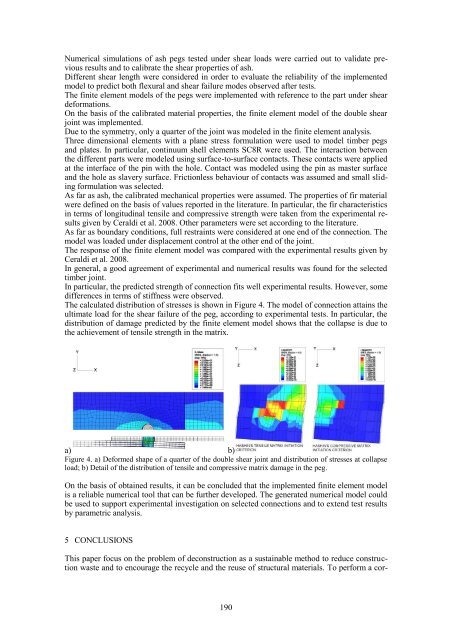
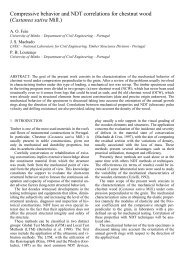
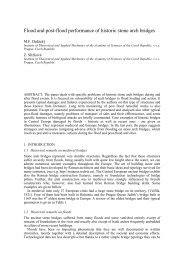
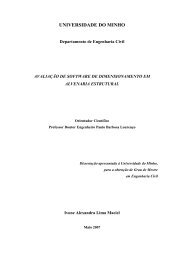
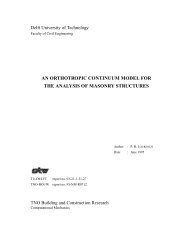

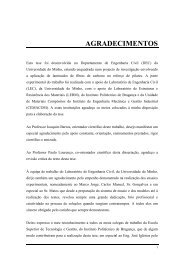

![Weibull [Compatibility Mode]](https://img.yumpu.com/48296360/1/190x134/weibull-compatibility-mode.jpg?quality=85)
